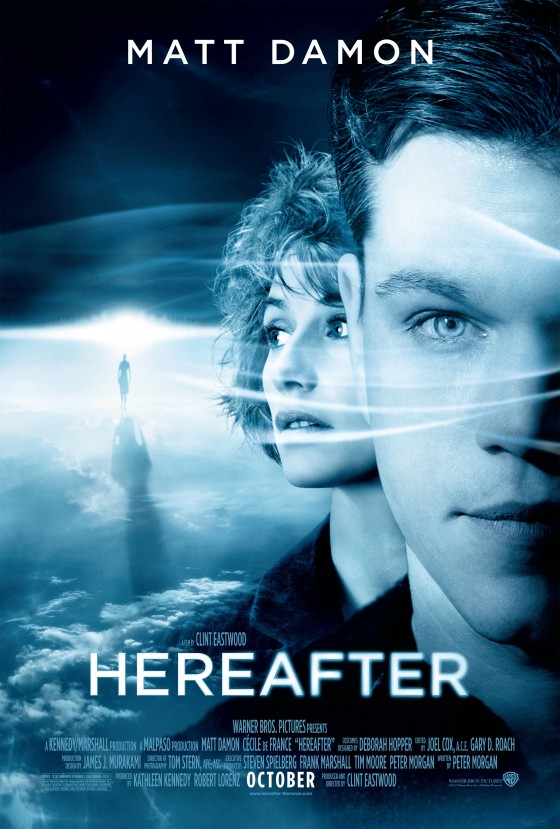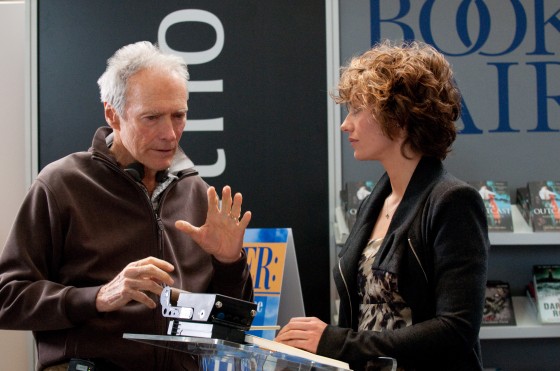 The new Clint Eastwood directed movie, Hereafter, starring Matt Damon, takes place in 2004 and 2005, opening with the terrible Tsunami that tore through Southeast Asia . We are introduce to the News Anchor Marie LeLay, played by Cecile De France, who is there vacationing with her producer/boyfriend. Out shopping for last minute presents before they leave, Marie is caught in the Tsunami and we are made to believe that she died at least for a few minutes before being revived. This sets up the entire underlying force of the movie, what is death and what happens after you die?
This movie consists of three vignettes that are then all tied to together in the last act. Matt Damon, playing a psychic named George living in San Francisco , turned his back on his gift to work in a factory. His brother Jay Mohr doesn’t understand why and keeps pushing George to use his abilities. We are shown, in a particularly effective scene, why George’s abilities have left him utterly lonely. We also continue to follow Marie as her near death experience consumes her life, destroying her professional reputation in secular France as she seeks to find answers to what she experienced.
The new Clint Eastwood directed movie, Hereafter, starring Matt Damon, takes place in 2004 and 2005, opening with the terrible Tsunami that tore through Southeast Asia . We are introduce to the News Anchor Marie LeLay, played by Cecile De France, who is there vacationing with her producer/boyfriend. Out shopping for last minute presents before they leave, Marie is caught in the Tsunami and we are made to believe that she died at least for a few minutes before being revived. This sets up the entire underlying force of the movie, what is death and what happens after you die?
This movie consists of three vignettes that are then all tied to together in the last act. Matt Damon, playing a psychic named George living in San Francisco , turned his back on his gift to work in a factory. His brother Jay Mohr doesn’t understand why and keeps pushing George to use his abilities. We are shown, in a particularly effective scene, why George’s abilities have left him utterly lonely. We also continue to follow Marie as her near death experience consumes her life, destroying her professional reputation in secular France as she seeks to find answers to what she experienced.
In the last vignette we follow the lives of the twin London boys, Marcus and Jason, as they deal with not only a drug addicted mother who social services is trying to take them away from, but also an accidental death that takes one and leaves the other trying desperately to come to terms with it.
On paper, this must seem like a good story. The problem is that only the boys’ story really stands on its own. Frankie and George McLaren, playing Marcus and Jason, do a really good job at showing enabling children and also how that bond can be both a blessing and a curse. They also do a great job at being the audience skeptical take on a lot of the hogwash psychics that are out there, and how they take advantage of the pain of others. But both the French and American story lines feel hollow.
The main reason for this is actually featured in the American storyline. This story feels like it is a homage to Charles Dickens, who happens to be George’s favorite author. The separate storylines all being pulled together so everyone ends up knowing each other in the end is very Dickenesque. The problem is that both Miss Havisham and the Prisoner have such wonderful character qualities that their subplots in Great Expectations make you want to know more about them but we get stuck with a couple of Pips who are just boring.
Another odd aspect of this movie is the use of score. In many moments it is utterly quiet and that is quite effective. But then when it adds score it makes it very noticeable and it is not that good. It seems very cheesy, hitting you over the head with what emotion you should be feeling at that moment. Any chance of the ending hitting home was lost because the score was so overpowering syrupy that it almost seemed sarcastically so.
 The performances overall are very good. The only real standout for a bad performance was Jay Mohr. He was not believable at all and the last scene we see him in he seems to be almost acting for a comedy. He is normally a good actor so I don’t know where this performance came from.
The performances overall are very good. The only real standout for a bad performance was Jay Mohr. He was not believable at all and the last scene we see him in he seems to be almost acting for a comedy. He is normally a good actor so I don’t know where this performance came from.
Even though this is filled with negativity, it is still a decent movie. The graphics are good and there is a lot of emotion. It just seems poorly assembled and really seems like it needed more time to cook. This is a movie that if on TV is worth watching or if there isn’t anything good new releases at the video store, but skip it in the theaters. There are too many better movies to spend the price of admission on.
- Diane Ligman
